The Dell XPS 17 9700 has a charging problem - connertweat1943
The red-hot Dell XPS 17 is drop-dead gorgeous, thin, relatively speeding, and has what looks like a potentially indicate-fillet charging problem.
How serious is it? We'll just say that based along our review unit, it's enough to recommend that you order a pause along a potential buy up until the trouble is addressed by Dell.
The charging issue first came to light on July 10, when respected engineering science internet site Notebookcheck.com reportable that its XPS 17 9700 review unit of measurement discharged the battery under expectant loads even when plugged into the wall.
This probably isn't a surprise to anyone who pays attention to the dishonorable hero of laptops: the power brick. When we saw that Dell had chosen a 130-watt USB-C courser for the XPS 17, we even expressed our concern in a video posted on YouTube in May.
If you get into't have fourth dimension to watch the telecasting, you should know that the vast majority of laptops we've seen with six- and eight-core CPUs plus GeForce RTX 2060 GPUs feature 180-Watt power bricks using conventional "barrel" plugs.
Why exercise a inferior powerful lighter power brick?
Why use "exclusive" a 130 watt power brick? The answer is less weight and slightly less bulk. That may seem trivial to numerous, but the XPS 17's 130-watt brick weighs just shy of a hammer (0.9 pounds, to be accurate). A typical 180-James Watt brick weighs about 1.3 pounds, about 30 per centum heavier.
Index consumption on a laptop computer isn't constant, either. Doing light tasks you might use 40 Watts, while a video encode power use of goods and services 100 watts.
Dell's maths is that most people are non going to get-up-and-go a laptop to 11 all day long. Instead, they power push it to 11 for a uncomplete-60 minutes or maybe an hour. For those multiplication when a laptop is actually drawing more than the 130-watt major power brick sack have, Dell uses a "hybrid" system, where it will tap the reserve power from the battery for the hour roughly it's needed, then recharge the battery once the heavy consignment is done. The end result is a lighter general weight connected the road.
Dingle isn't the first to do this. Microsoft's Surface Book 2 did IT, as have others WHO used smaller power bricks to raise portability. For every person who argues a 17-inch laptop like this should be designed to run at 100 percent altogether day, every day, there's a person who argues they'd rather have little weight unit in their old bag.
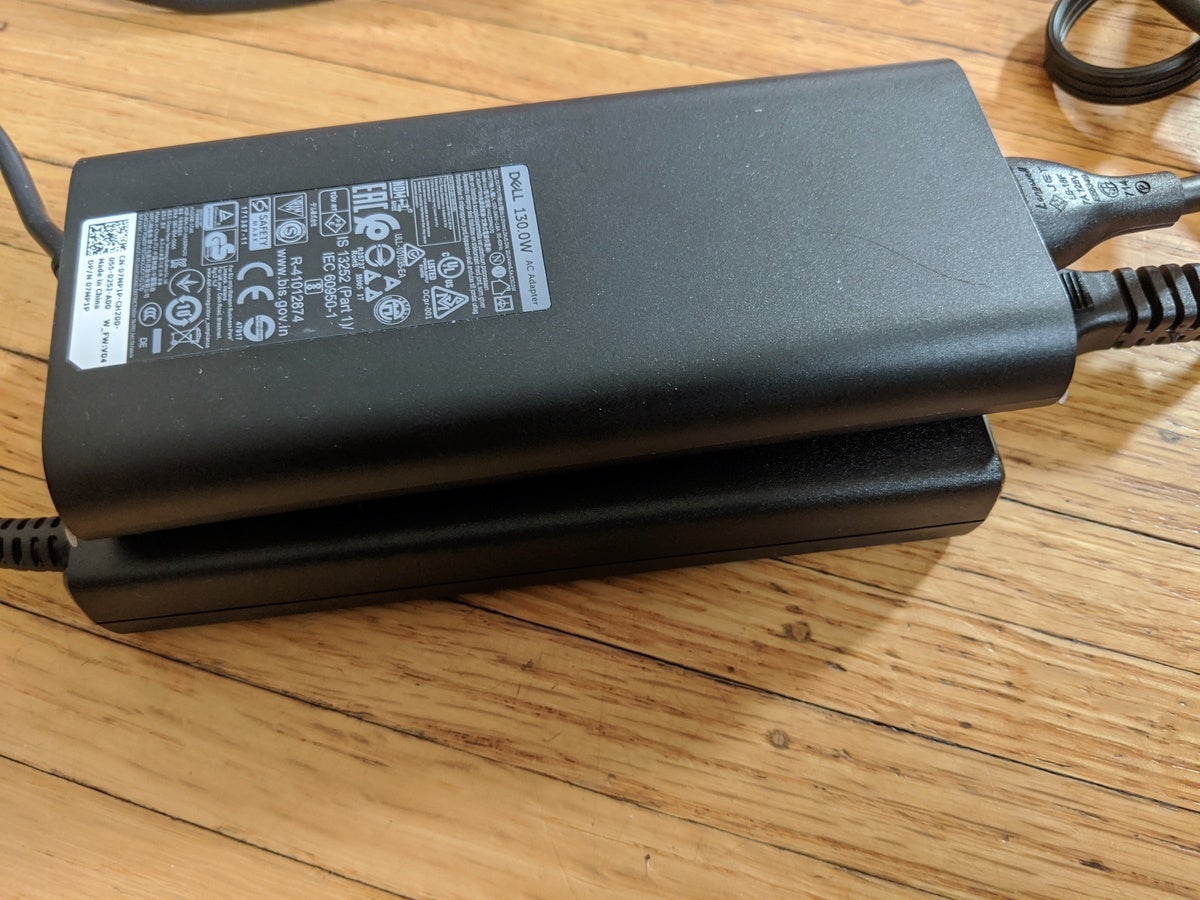 Gordon Mah Ung
Gordon Mah Ung The Dell XPS 17 9700's 130-watt power brick is only slightly less bulky than a emblematic 180-W power brick, but it's about a third lighter.
Here's where it gets tricky
If you swallow the truth that all laptops are a balance of temperature reduction, performance, acoustics, weight and cost, you might say no big whole slew. We mightiness even agree, except the problem with the XPS 17 9700 appears to run deeper than a "hybrid" under-sized power brick design choice.
As Notebookcheck.com found in its testing, and we've duplicated in our own critical review unit from Dell, the XPS 17 9700 doesn't seem to be fit to reach 130 watts from the already under-ninepenny power brick.
One affair we want to note is that piece Notebookcheck.com's social unit and our unit seem to make out the same thing, opposite reviewers apparently haven't stumbled upon this takings. Approximately users on Reddit have reported the same experience, but it's possible the problem is moderate to our unit, Notebookcheck's, and those of some unlucky folks on Reddit. We can't read information technology's a blanket issue with all Dell XPS 17 9700 units.
We can say we reproduced information technology, though.
We first took the XPS 17 9700's 130-James Watt power brick and connected it to the Dell XPS 15 9500 that we sporty reviewed. Information technology actually uses the same power brick as the XPS 17 9700, but we used it with the XPS 17's power brick to help eliminate variables. We then measured the power consumption at the wall socket of the XPS 15 9500 subordinate various loads using a logging watt meter. In the chart below, you potty imag the red line representing Watts consumed at the wall every irregular.
We first trigger Maxon's Cinebench R20. This particular test is pure CPU and does not cutaneous senses the GPU. The XPS 15 9500 spikes capable about 130 watts and so tiers down as the mould progresses.
We then started the Central processing unit-intensive game, PUBG, setting the in-gritty result to 1920×1080 and Metier choice. With the CPU and the GPU working, the laptop is pulling 130 watts at the wall.
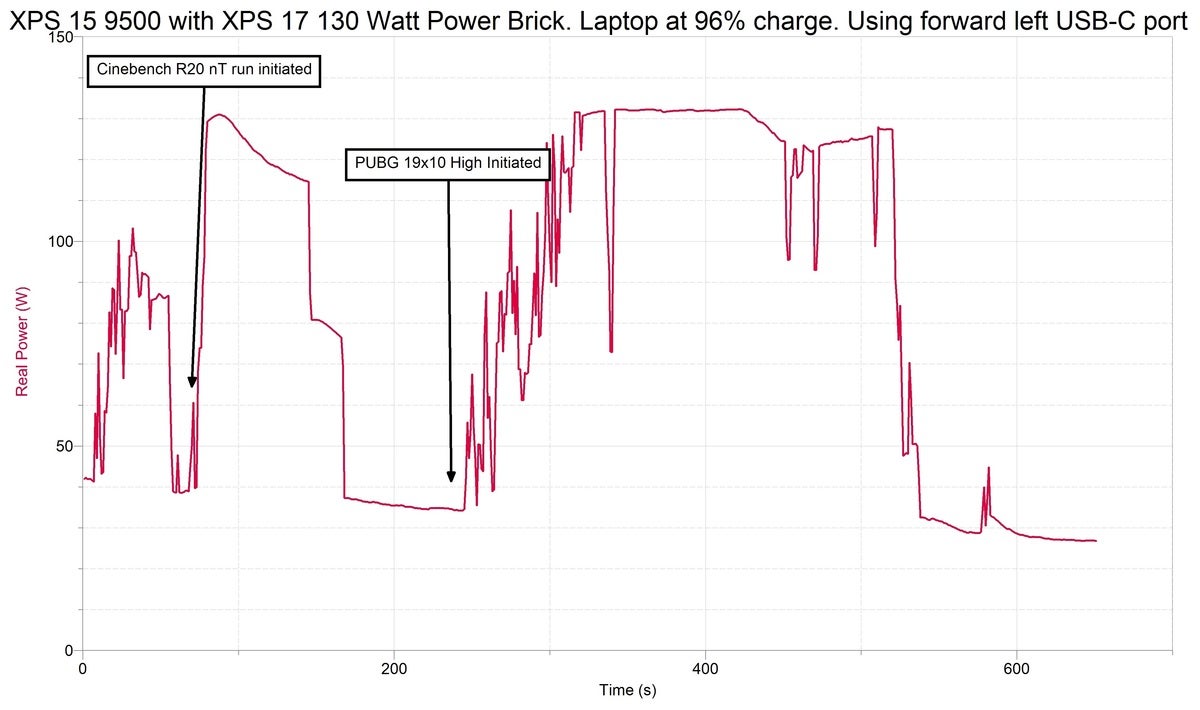 IDG
IDG The XPS 15 9500 is healthy to draw 130 Isaac Watts from the XPS 17 9700's 130-watt power brick.
We and then powered down the XPS 15 9500 and plugged the same power brick into the XPS 17 9700. If you look at the chart, the colored line again represents wattage used-up at the wall by the laptop. Running Cinebench R20, the XPS 17 draws about 105 watts at the surround. We past started PUBG set to 1920×1080 and Medium select, and again, we see the laptop volition draw no much 105 units at the fence in. In neither of those runs did we see noticeable battery discharge.
We and so started Quake II RTX and ran the in-game bench mark. Again, we see roughly 105 watts maximum draw from the laptop computer. With both games, we didn't see discharge during the mindless sentence we ran them.
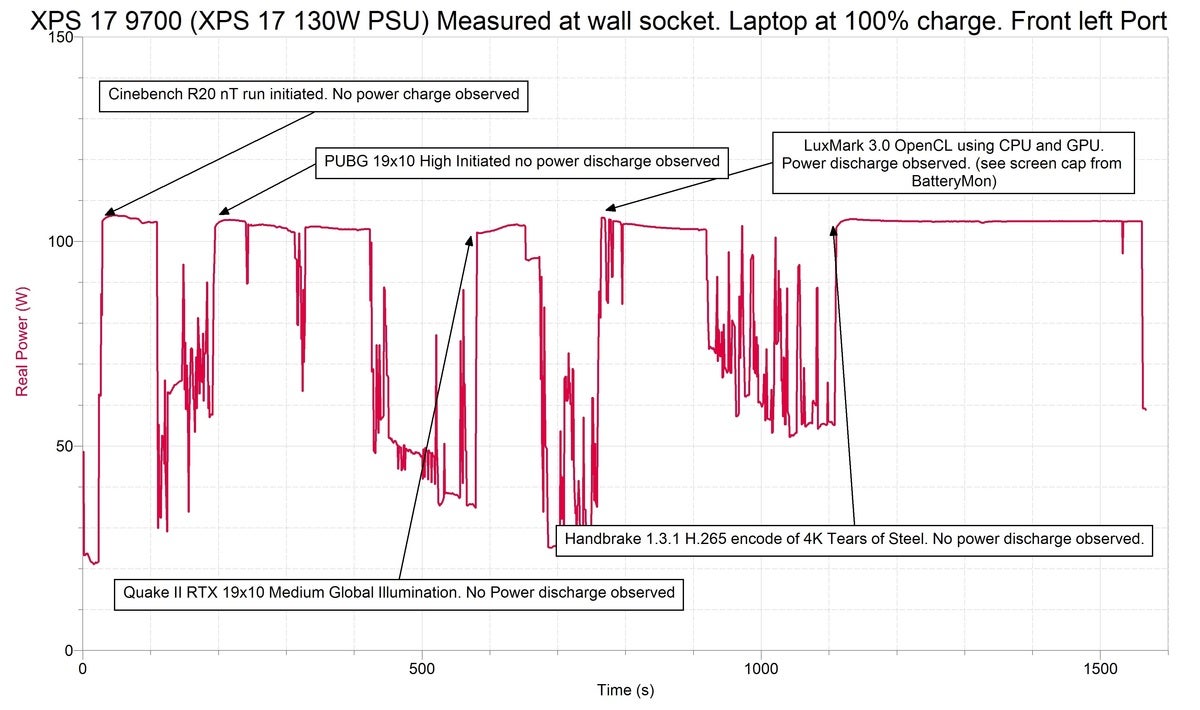 IDG
IDG We could never get the XPS 17 9700 to draw more than 105 watts from its 130-watt power brick.
We next ran LuxMark 3.0, an OpenCL benchmark that can be run simultaneously on the separate GPU and the integrated Intel graphics. With this intense workload, we actually did lead off to observe a sacking of about 7 watts from the battery during the run.
The fourth-year test we ran was a HandBrake 1.3.1 HEVC encode victimization the CPU cores, not the discrete artwork or Intel QuickSync ironware. While no power discharge was observed, we once more see the laptop will draw no longer than 105 watts from the 130-watt power brick.
 Gordon Mah Ung
Gordon Mah Ung At best, the XPS 17 9700 wish draw 105 to 107 watts from its 130-watt power brick.
Of all of the tests we ran, we observed discharge rates only during the LuxMark 3.0 bench mark. That shouldn't cause you take a breath a sign of relief, though, because IT's actually quite easy to induce power discharges from the laptop nether what we believe are reasonable loads.
To test that we restarted PUBG and have IT sit in few breeding matches. Victimisation Passmark's BatteryMon, we and so logged the discharge rate of the bombardment with the gritty set to 1920×1080, Ultra timber. The screen brightness (which consumes several watts of power) was set to its high setting and, of course, Wi-Fi is connected, which also consumes big businessman. BatteryMon reported the battery discharging at about 7.2 watts. The laptop computer's execution was determined to Optimized for this run, which should technically use a pocket-size less power than its Ultra Performance setting.
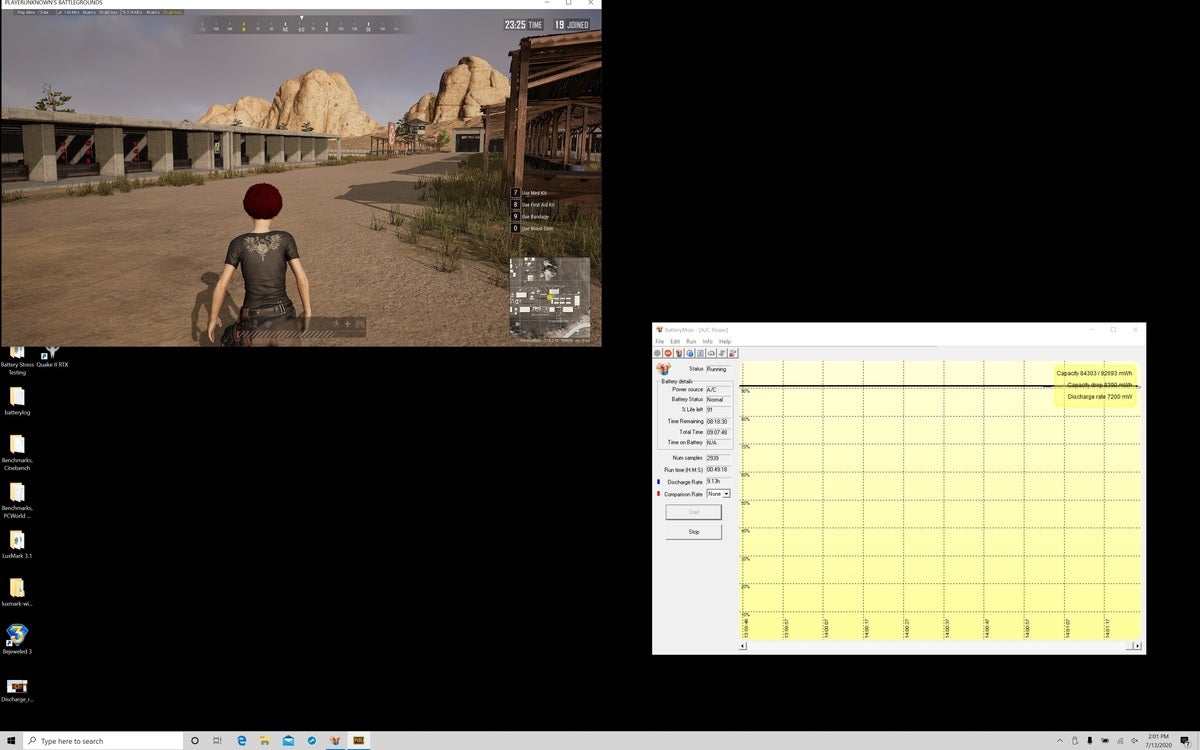 IDG
IDG PUBG will have a superpowe discharge from the Dell XPS 17 9700's battery even when on AC.
This obviously begs the question of antimonopoly how much the XPS 17 9700 wish discharge. To find out, we let PUBG foot race direct four training Roger Huntington Sessions and so get it sit in at the main lobby, which is a 3D scene. Even if IT's non heavy gaming, it's shut up enough to keep open the GPU continual at its rated draw of 65 watts.
At just low-level five hours, we restrained the laptop: The battery had dropped to 23 percent. You can learn this in the graph below using data from Passmark's BatteryMon. The power run out, if BatteryMon is correct, actually increased Eastern Samoa meter dragged happening, and we saw nearly 15-watt discharge rates from the battery. At 23-percent capacity, the battery drain Chicago—but the ensnare rates also drop. We harbor't verified this, but we suspect this is the point where the XPS 17 9700 sheds execution sooner than eat into its battery reserve.
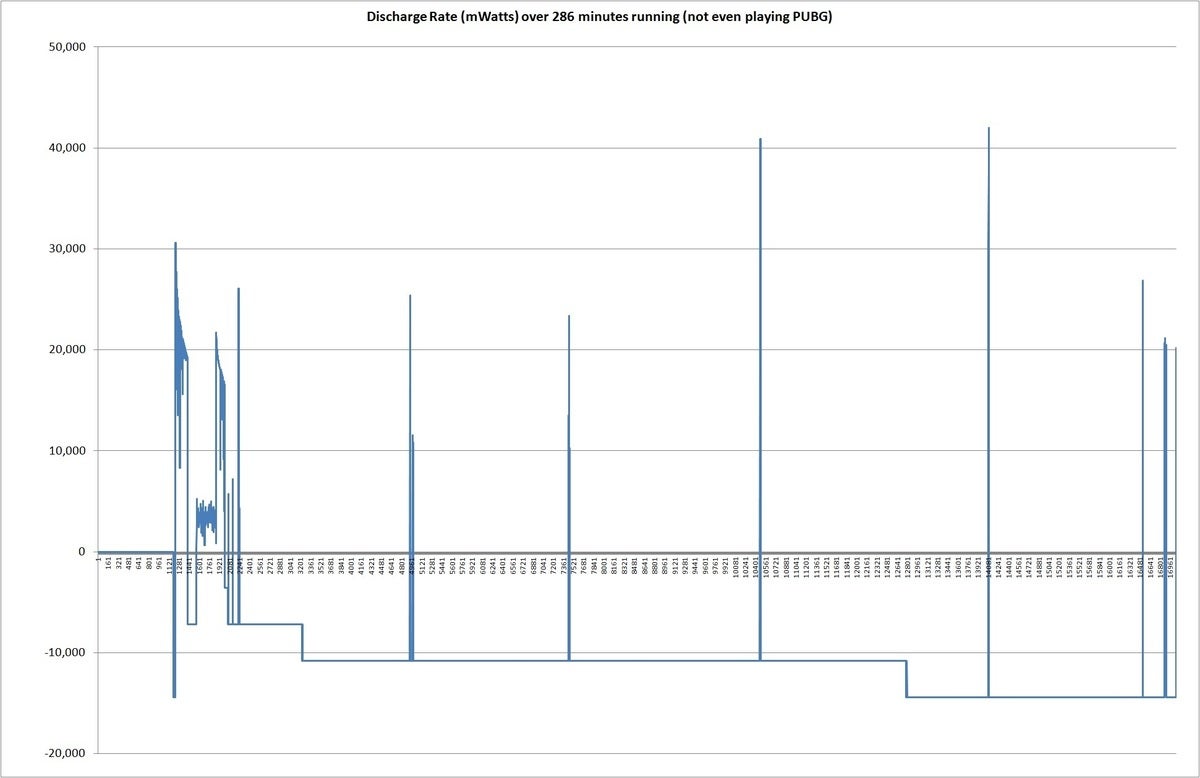 IDG
IDG The XPS 17 9700 will draw down its battery to 23 per centum before the bleeding stops.
Wherefore this is happening
PCWorld contacted Dingle with our findings. Officials aforementioned they are looking into why our unit is non charging at more than 105 watts, but there's no official comment yet.
We do own a jolly white estimate of what's up, though. As the mantra of the XPS 17 9700 is sleek beauty, you actually can't say that with a serious face while victimization the conventional and ugly-as-hell on earth assail drum battery charger we're used to using with fatter play laptops. Hardware reviewers ruckle their noses at such things, and most people think they'ray a relic.
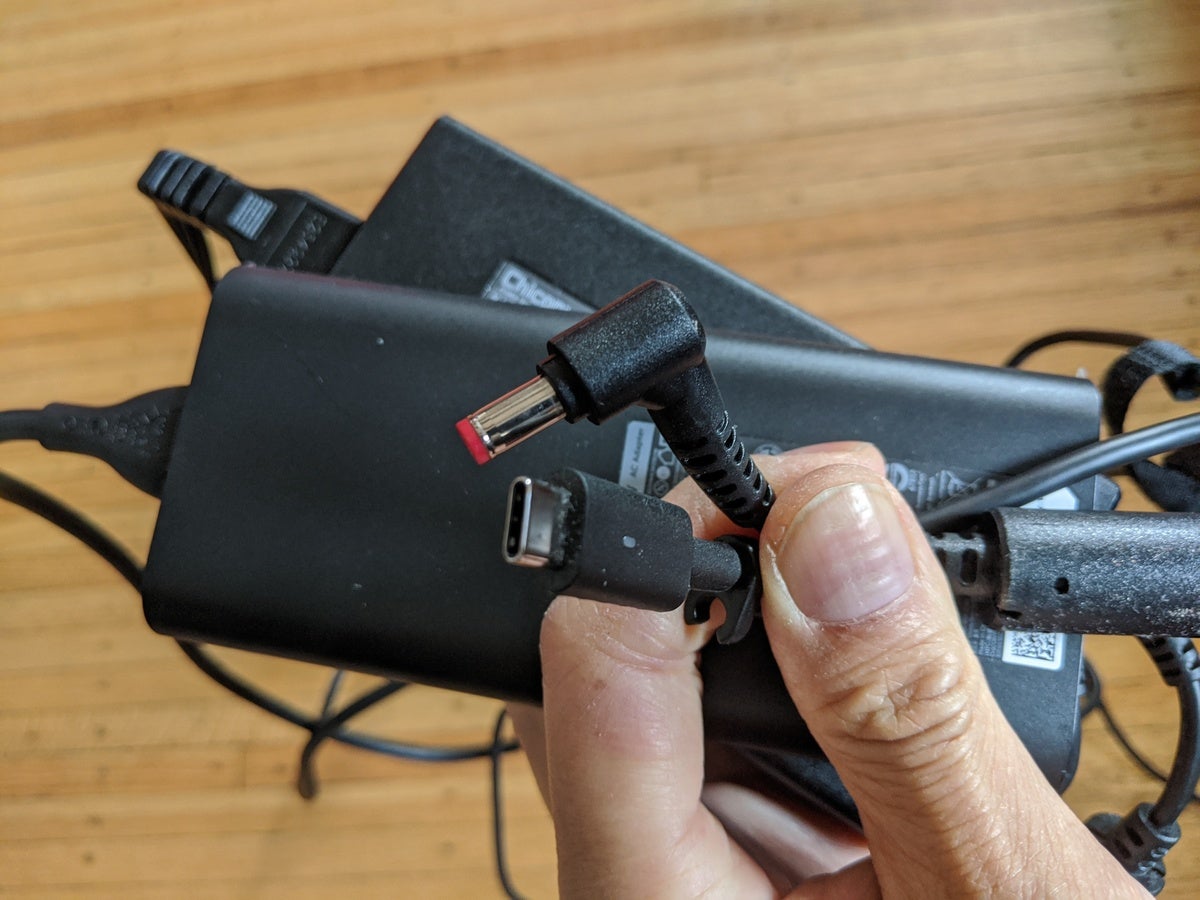 Gordon Mah Ung
Gordon Mah Ung The USB-C power brick on the XPS 17 9700 means you can charge your phone or tablet as well your laptop with nonpareil charger. The more typical barrel charger is seen mostly as an unfortunate relic today.
For the XPS 17 9700, and the XPS 15 9500, Dingle adopts the modern-Clarence Day USB-C plug. The problem with USB-C and the USB Power Delivery specification, though, is that information technology's currently controlled to a maximum of 100 watts. That's just not enough, then Dingle does a bit of a "cheat" at the limited power spec by construction intelligence into the laptop computer's charging circuit and the power brick to have it do a special Dingle shake. If the handshake happens, the power brick breaks spec and supplies equal to 130 Watts of power. Plug that Dingle 130 power brick into a MacBook In favour of 16 or HP Apparition x360, though, where they wear't know the special handshake, and the power brick bequeath provide only up to standard USB-PD specifications.
We remember that somehow, our XPS 17 9700 unit and apparently at least a few others never knowledgeable the proper Dell handshake. Therefore, the 130-watt power brick will supply only 100 watts, as if it were an Apple or HP product.
This lower output doesn't reflect well on the Dingle XPS 17 9700's hybrid design. We suspect that if the brick supplied 130 watts, as was intended, the discharge rates running intensive tasks would be much harder to reproduce. The XPS 17 9700, atomic number 3-is, is running with 20 percent less magnate than intended, so even short and simple benchmarks can rush discharging.
Ass this embody fixed?
The $9,700 question is whether this can easily comprise geosynchronous. Again, Dell officials are still investigating the power negotiation issue we suspect to personify at the heart of this, but the fellowship has made no statements yet.
We believe information technology's something that could be corrected by a firmware update to an integrated accountant in the laptop. If this ends happening a good enough note, Dell will issue a firmware or UEFI update, we'll all patch it, and past we give the sack get back to debating the merits of "less weight vs. much electrical power" in great power bricks.
If this ends badly, however, it could all right mean new power adapters or even possibly sending laptops stake for a set up.
Far worse, however, would be for Dell to say running an 8-core Marrow i7-10875H, GeForce RTX 2060 Max-Q, 32GB of RAM and 500-nit 4K screen on 100 Watts is just close-grained and within spec.
To US, it's clearly not.
 Dell
Dell The left side of the new XPS 17 9700 features ii Thunderbolt 3 ports and a wedge-style lock.
Source: https://www.pcworld.com/article/393186/the-dell-xps-17-9700-has-a-charging-problem.html
Posted by: connertweat1943.blogspot.com

0 Response to "The Dell XPS 17 9700 has a charging problem - connertweat1943"
Post a Comment